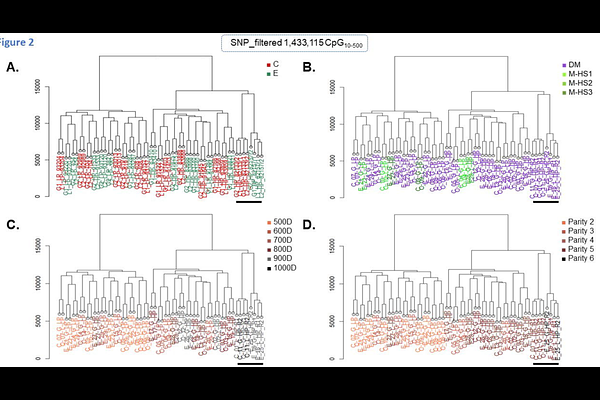The effect of environmental enrichment on immune cell DNA methylation profiles depends on the parity of sows.

The effect of environmental enrichment on immune cell DNA methylation profiles depends on the parity of sows.
Lopes, M. M.; Monteiro Moreira, G. C.; Chaulot-Talmon, A.; Frambourg, A.; Costes, V.; Demars, J.; MERLOT, E.; JAMMES, H.
AbstractThe aim of this study was to identify epigenetic markers that reflected positive affective states in multiparous pregnant sows. The animals were housed during gestation in either a conventional (C) environment (2.4 square meter per sow), featuring a concrete slatted floor and minimal enrichment, or in an enriched (E) environment (3.5 m square meter per sow) with deep straw bedding. Peripheral blood mononuclear cells (PBMCs) were isolated at day 98 of gestation (G98) and day 12 of lactation (L12) for genomic DNA extraction and reduced representation bisulfite sequencing (RRBS). Significant effects of individual class of parity (low-parity (LP) versus high-parity (HP)) were observed with the identification of 1,358 and 680 differentially methylated cytosines (DMCs) at G98 and L12, respectively. Interestingly, some of them are organized into differentially methylated regions (DMRs). Some DMRs colocalized with or near a gene and displayed a continuous methylation distribution (44 at G98 and 15 at L12 including 4 in common): 5 targeted genes are related to epigenetic regulation (DNMT3A, KDM8, HDAC4, SIRT2 and U2) and 12 to immune function (CD2, CD5, CAMK4, SECTM1, URODL1, CMIP, SEC14L1, SKI, TNFRSF1B, CCND3, SGK1, PACS1). These results suggested a true epigenetic impact of parity class on individual immunity. Considering the two parity classes separately, a minor effect of environmental enrichment was observed (at G98: 60 and 42 DMCs; at L12: 35 and 81 DMCs, in the LP and HP groups, respectively). Remarkably, some DMC-associated genes had previously been linked to affective states in humans. In conclusion, unexpected DNA methylation changes associated with parity class were identified, suggesting a genome adaptation during reproductive life and modifying the response to housing conditions. Furthermore, specific CpG sites emerged as potential biomarkers of positive affective states in pigs. https://www.ebi.ac.uk/ena/browser/home - PRJEB90105 / ERP173119 https://doi.org/10.57745/0GWNEV - Recherche Data Gouv. and referenced under MERLOT, Elodie; JAMMES, Helene, 2025, \"BEPPI project - data, tables and figures on sow peripheral white blood cell epigenome\".